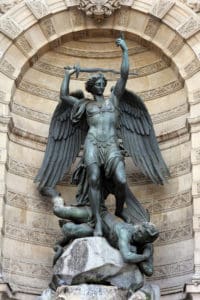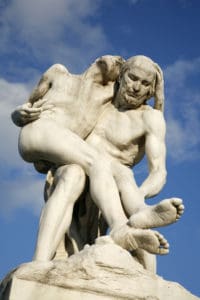In the time of Jesus, his family and friends and countrymen thought there were two main ways to salvation, and they argued about which was the better way.
Before we talk about these Two Ways of Salvation, we should first define what we mean by “salvation.” It meant something different two thousand years ago than it does today.
If you ask an American Christian in the 21st century what “salvation” means, they’ll tell you that it has to do with going to heaven when you die. And making sure you avoid the other place.

But that is not what Jews in the time of Jesus meant by “salvation.” We know what they meant, because we have a fairly large number of documents that various Jews wrote during the last couple of centuries BC and the first couple of centuries AD.
What “Salvation” Meant in the Time of Jesus
In the time of Jesus, if you asked a Jew living anywhere within a hundred miles of Jerusalem what “salvation” means, they’d tell you something like this:
“Our nation is in terrible shape. God promised this land to our father Abraham. Moses brought us here, and David built a great kingdom here. But then we sinned, and the Babylonians took us into captivity. We came back and rebuilt, but the Persians oppressed us, and then the Greeks, and then the Syrians. For about a hundred years, we had our own Jewish kings. But they were corrupt and sinned, and the Romans came to oppress us.
“We have prophecies that say God will restore our nation. An anointed king will arise, a son of David, and with God’s help, we’ll drive out Rome. Then God will come to live among us, and at last we’ll have the kingdom of God we always dreamed of. That is what salvation means—that our nation will have God as its king. We’ll live in peace. God will raise our dead to life. And he’ll bring the wicked nations to judgment for the harm they did to us.”
See the difference? Our modern definition of “salvation” is intensely personal—it’s all about me and whether I get to heaven. The ancient Jewish definition of “salvation” was national—it’s all about whether my nation will live at peace in the coming kingdom of God.
Now notice that there’s a personal element in the ancient Jewish definition. Because even if my nation lives at peace in the kingdom of God, I still need to make sure that I’m a member of my nation in good and regular standing. If I should do something to get kicked out of my nation, then I wouldn’t enter into our national salvation.
The Many Flavors of the Kingdom of God
It’s easy to think that everyone means the same thing by the term “kingdom of God.” According to the gospels, this was a phrase Jesus used many times. (The gospel of Matthew generally uses “kingdom of heaven,” in place of “kingdom of God.”) Other Jews at the time of Jesus used various phrases: “the World to Come,” or “the Age to Come,” or “the Age of the Messiah.”
But it appears that different people meant slightly different things by “kingdom of God.” The Hebrew prophets talked about a restored kingdom of David, in which a righteous Branch of the house of David would rule over the same territory David ruled.
But later writings from around the time of Jesus talk about the coming kingdom in a variety of ways. Some seem to have believed that the new kingdom would be here on earth, as the prophets had said. Others seem to imply that this present earthly reality might come to an end, to be replaced by another heavenly reality.
But almost everyone was quite certain that the new kingdom of God was coming soon, and they hoped to be part of it.
(The party of the Sadducees appears to be the exception. They were the wealthy oligarchs who ruled as high priests in the Temple in Jerusalem, and they were quite happy to work with the Romans to keep the status quo. They hated the Romans as much as anyone else, but they were doing well under the System. They saw no need to try to fight a superior military power when there seemed no chance of winning.)
The Two Ways to Salvation
As I said above, Jews at the time of Jesus desperately wanted national salvation. Liberation from Rome, the new messianic age, and the kingdom of God. Even if they didn’t agree on exactly what the kingdom of God looked like, they wanted it. And they believed that the prophets had foretold that the time would come very soon.
But they had two very different approaches to how to achieve the kingdom of God and national salvation:
- Anoint some son of David as a new messianic king and take up the sword. Fight the Romans, drive them into the sea, and set up the new kingdom with the son of David on the throne. Men must first take action, and then God will certainly bless their efforts, and so Israel will find salvation.
- Wait for God himself to act decisively in history, as foretold in the book of Daniel and the book of Enoch. A “Son of Man” will come down from heaven to fight on behalf of True Israel. This “Son of Man” will be the same “Angel of God” who killed the first-born sons of Egypt at the time of Moses. He will come down on the clouds of heaven and destroy Rome and set up the new kingdom of God. Then a son of David will rule as king, and True Israel will find salvation without ever having to fight on her own behalf.

Method #1 above was exactly how Jews achieved national freedom two centuries before Jesus, when the Maccabee heroes took up the sword, fought the Syrians, drove them out of the land of Israel, and set up a kingdom ruled by priests. (The five Maccabee brothers were priests, and their dynasty ruled as priest-kings for over a century.) So we might call this method of salvation the “Maccabee Way,” because it had worked out very well in recent memory. The Jewish festival of Hanukkah is celebrated to this day to honor the Maccabee victory.

Method #2 was exactly how Jews told their tale of national liberation from Egypt at the time of Moses. No Hebrew in ancient Egypt took up the sword. Not a single Hebrew killed an Egyptian. Instead, a mighty prophet rose up, Moses, and he called down smites from heaven on Egypt. And the last and greatest smite on the Egyptians came on the very first Passover Eve. The Angel of God went through all the land of Egypt, killing the firstborn son of every house. The Hebrews marked themselves out for salvation as part of the Hebrew nation by putting the blood of a lamb on their doorposts. That was all they did. The Angel of God fought on their behalf, and so they entered into national salvation.
In the time of Jesus, everyone knew that the book of Daniel promised that the Angel of God (“one like a Son of Man”) would judge the nations. And at the time of Jesus, a new book had recently come into circulation. Today it’s called “The Parables of Enoch” and it forms chapters 37 to 71 of the Book of Enoch, a very famous apocalyptic work. The Parables of Enoch told how the Son of Man would bring in justice, punish the wicked, create the new kingdom of God, and give salvation to all of True Israel. So we might call this method of salvation the “Enoch Way,” because it was pushed so heavily by this new book, The Parables of Enoch.
Groups Who Followed The Two Ways of Salvation
At the time of Jesus, different groups got behind each of these Two Ways of Salvation.
The Essenes (or whoever it was that lived in Qumran) appear to have thrown their weight behind the Enoch Way. The Qumran community left behind a number of apocalyptic texts in the famous Dead Sea Scrolls. These texts include the various books attributed to Enoch, along with the War Scroll, which told about the coming War Between the Sons of Light and the Sons of Darkness. The people of Qumran thought they were the Sons of Light. They believed that the Angel of God would fight on their behalf. So when the Jewish revolt broke out in the year AD 66, the Qumran community sat by and refused to fight, expecting the Angel of God to do all the fighting. They were wiped out by Rome anyway.
The majority wing of the Pharisee party seems to have followed the Maccabee Way. War broke out in AD 66 when a number of revolutionary young Pharisees decided that enough was enough. They rebelled against Rome, slaughtered the small Roman contingent of soldiers garrisoned in Jerusalem, and took up arms against Rome. They destroyed a large Roman force at the famous Battle of Bet Horon. Meanwhile, in Rome, the emperor Nero had so brutalized the aristocrats that they finally began pushing back. By the summer of AD 68, Nero committed suicide as his own army moved in to capture him. God appeared to be blessing the efforts of his loyal Jewish soldiers.
A minority wing of the Pharisee party rejected the Maccabee Way. The great rabbi Yohanan ben Zakkai opposed the Jewish revolt and left Jerusalem in the middle of the war. It’s not entirely clear whether Rabbi Yohanan followed the Enoch Way. We don’t have anything he wrote himself. All that we know of him was written centuries later in the Talmud. But Rabbi Yohanan most likely was a student of the famous Rabbi Gamliel, and we have a first-century source in which Rabbi Gamliel says, in essence, that God is in control of the revolution. (Acts 5:33-39). And that sounds a lot like the Enoch Way.
The Two Ways of Salvation in the Gospels
If you read the gospels, you’ll find many verses that allude to the Two Ways of Salvation.
One of Jesus’s twelve disciples was called “Simon the Zealot.” In the first century, zeal for God meant that you were pursuing salvation by the sword. So it’s pretty clear that Simon the Zealot followed the Maccabee Way and was eager to take up the sword and fight Rome. At the Last Supper, somebody laid a couple of swords on the table. Simon the Zealot may have owned one of them. Simon Peter may have owned the other, because later that night he used a sword to cut off an unfortunate ear.
On Palm Sunday, all four gospels tell how Jesus made a triumphal entry into Jerusalem riding on a donkey. See my recent blog posts on this, Jesus and Palm Sunday and Jesus of Nazareth, King of the Jews.
The people waved palm branches while Jesus came down the Mount of Olives. Palm branches—exactly what people waved for the victorious Maccabees two hundred years before. It’s a good bet these people on Palm Sunday followed the Maccabee Way.
Jesus himself talks about the “men of violence” who try to enter the kingdom through violence. (See Matthew 11:11-15). That’s the Maccabee Way yet again.
But if you look through the gospels, you’ll also see many references to the “Son of Man.” These references have been debated endlessly by biblical scholars. It seems likely that some of these references hark back to the “Son of Man” in the book of Daniel. And as we’ve seen, people who loved the book of Daniel also tended to love that new book, The Parables of Enoch. So when Jesus talked about the “Son of Man,” his hearers probably thought he was talking about the Enoch Way, whether he actually was or not.
What about Jesus himself? Did he follow the Maccabee Way or the Enoch Way? Biblical scholars have written massively on exactly what Jesus hoped to achieve in the last week of his life. You can find all kinds of theories, but you can’t find a consensus.
The Third Way of Salvation
My thinking is that Jesus followed a new way, which we might call the Third Way of Salvation. It’s the way of nonviolence. Of enemy love.

In the gospels, you’ll find numerous sayings of Jesus along the lines of, “love your enemies,” and “pray for those who despitefully use you,” and “make peace with your brother,” and “turn the other cheek.” The Tale of the Good Samaritan is a classic story of enemy love.
The Third Way of Salvation deals with enemies by loving them, thereby turning them into friends. The Third Way of Salvation makes your enemies vanish without harming them! That’s deep.
And it seems clear that the Jesus Community in Jerusalem lived by this Third Way. Sometime shortly before the Jewish revolt of AD 66, the Jesus Community left Jerusalem. The historian Eusebius tells us this was because of “an oracle.” Which oracle was that? Presumably one of the sayings of Jesus in which he warns his disciples to leave Jerusalem before it’s destruction. (See Mark 13, Matthew 24, and Luke 21 for some sayings of Jesus on the coming destruction of the Temple and the need to “flee to the mountains.”)
So the Jesus Community refused to take up the sword and fight Rome. They also refused to sit passively and wait for the Angel of God to destroy the Roman army. Instead, they followed the words of Jesus and left the city and moved across the Jordan river to a small city named Pella.
And they lived on. Because they followed the Third Way of Salvation. The Way of Jesus. And in time, many decades later, the Way of Jesus conquered Rome itself.
Not by the Maccabee Way, by taking up the sword.
Not by the Enoch Way, by the hand of the avenging Angel of God.
By the Jesus Way—by loving their enemies, by submitting to their enemies, and in some cases by accepting death from their enemies.
That’s the Third Way of Salvation, the way Jesus himself lived his life, the way he met his death, and the way that his followers understood to be the entrance to the true kingdom of God.

This has been an interesting read of your book, you have been mysteriously helping me to write my first fictional novel (based on non fiction), and I thank you for this perspective on Jesus, it is not so much about love for enemies but love overall for all persons because God will eventually fight our battles for us. A revelation was received that God does fight as an angel of death from heaven in that he defends us when we move into and take action based on our faith, and through our fight he opens doors and makes things possible for us to achieve. Thank you very much.
[…] popular theories on how to crush the Romans. You can read about those two theories in my blog post Jesus and the Third Way of Salvation. I’ll summarize briefly […]
[…] Want to know more about Jesus and his message of enemy love? Check out my blog post Jesus and the Bad Samaritans. Or take a look at my post Jesus and the Third Way of Salvation. […]
[…] or an angelic warrior—the Son of Man. (For more info on these beliefs, see my blog post Jesus and the Third Way of Salvation). So people thought the Kingdom of God would begin with an apocalyptic battle that defeated Rome […]